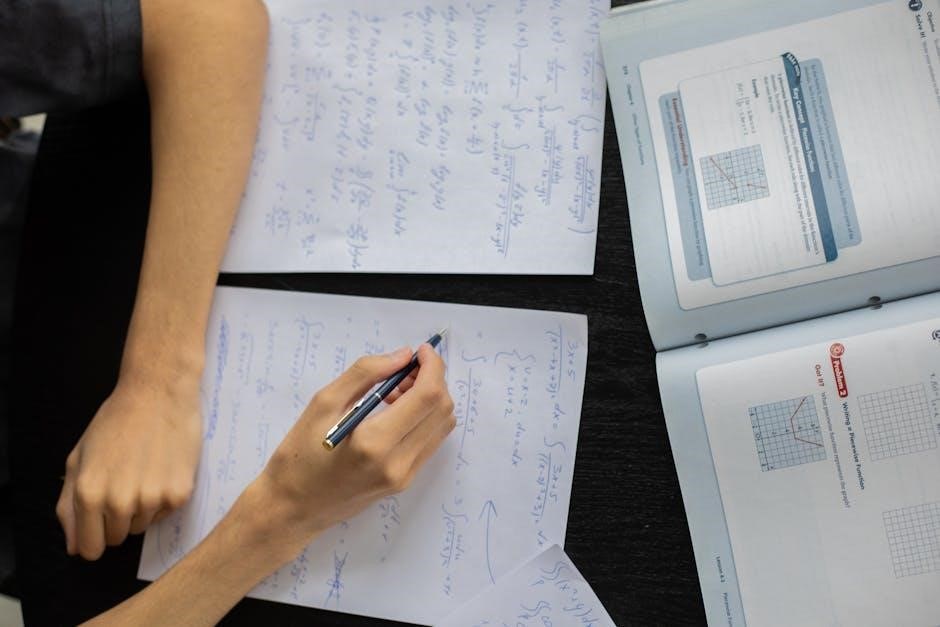Algebra 1 Final Exam: A Comprehensive Guide
The Algebra 1 final exam marks a significant milestone, assessing a student’s grasp of fundamental algebraic concepts. This guide serves as a comprehensive resource, offering a roadmap to navigate the exam successfully. It provides key insights, effective study strategies, and practice resources to enhance exam readiness.
Understanding the Exam’s Scope
Before diving into the specifics, it’s crucial to understand the overall scope of the Algebra 1 final exam. This involves recognizing the key areas of algebra that will be assessed, such as linear equations, polynomials, and quadratic equations. Knowing the exam’s structure, including the types of questions (multiple-choice, free-response), and the weighting of different topics, is also essential. This understanding allows students to allocate their study time effectively, focusing on areas where they need the most improvement.
Furthermore, grasping the exam’s objectives helps students align their learning with the expected outcomes. The exam typically evaluates a student’s ability to apply algebraic concepts to solve problems, reason mathematically, and communicate their solutions clearly. By understanding these objectives, students can approach their preparation with a clear sense of purpose, ensuring that they are not only memorizing formulas but also developing a deep understanding of the underlying principles.
Ultimately, understanding the exam’s scope empowers students to take control of their preparation, fostering confidence and reducing anxiety on test day.
Key Topics Covered in Algebra 1
Algebra 1 encompasses a range of fundamental topics that build a foundation for more advanced mathematics. The final exam will likely cover several key areas, each requiring focused attention during your preparation.
One core area is linear equations and inequalities, including solving for variables, graphing linear equations, and understanding slope-intercept form. Related to this are systems of equations, where you’ll need to solve for multiple variables using methods like substitution and elimination. Another significant area is exponents and polynomials, which involves simplifying expressions, performing operations with polynomials, and understanding exponent rules.
Factoring polynomials is a crucial skill, enabling you to break down complex expressions into simpler forms. This leads into quadratic equations, where you’ll learn to solve for roots using factoring, completing the square, and the quadratic formula. Finally, radicals and rational expressions require you to simplify, add, subtract, multiply, and divide expressions involving square roots and fractions with variables.
Mastering these topics is essential for success on the Algebra 1 final exam.

Linear Equations and Inequalities
Linear equations and inequalities are fundamental building blocks in Algebra 1. Mastering these concepts is crucial for success, as they appear throughout the curriculum and on the final exam.
A linear equation is an equation that can be written in the form ax + b = c, where a, b, and c are constants, and x is the variable. Solving linear equations involves isolating the variable using inverse operations. This includes addition, subtraction, multiplication, and division. Pay close attention to the order of operations and maintaining balance on both sides of the equation.
Linear inequalities are similar to linear equations, but instead of an equals sign, they use inequality symbols such as < (less than), > (greater than), ≤ (less than or equal to), or ≥ (greater than or equal to). Solving linear inequalities involves the same techniques as solving linear equations, with one important difference: when multiplying or dividing both sides by a negative number, you must reverse the inequality sign.
Practice solving a variety of linear equations and inequalities to solidify your understanding. Be sure to check your solutions by substituting them back into the original equation or inequality.
Graphing Linear Equations
Graphing linear equations is a core skill in Algebra 1, providing a visual representation of the relationship between two variables. Linear equations, when graphed, produce straight lines, making them easily identifiable and analyzable.
There are several methods for graphing linear equations. One common approach is using the slope-intercept form, y = mx + b, where m represents the slope of the line and b represents the y-intercept (the point where the line crosses the y-axis). To graph using this form, plot the y-intercept and then use the slope to find additional points on the line. The slope can be interpreted as “rise over run,” indicating the vertical change for every horizontal change.
Another method involves finding the x and y-intercepts. To find the x-intercept, set y = 0 and solve for x. To find the y-intercept, set x = 0 and solve for y. Plot these two points and draw a line through them.
Understanding how to graph linear equations is essential for visualizing solutions and analyzing relationships between variables. Practice graphing various linear equations to master this skill.
Systems of Equations
Systems of equations involve two or more equations with the same variables. Solving a system of equations means finding the values for the variables that satisfy all equations simultaneously. These systems are fundamental in modeling real-world situations with multiple constraints.
Several methods exist for solving systems of equations. The substitution method involves solving one equation for one variable and substituting that expression into the other equation. This reduces the system to a single equation with one variable, which can be easily solved. Then, substitute the value back into one of the original equations to find the value of the other variable.

The elimination method involves manipulating the equations to eliminate one of the variables. This is typically done by multiplying one or both equations by a constant so that the coefficients of one variable are opposites. Then, add the equations together to eliminate that variable. Solve the resulting equation for the remaining variable, and substitute the value back into one of the original equations to find the value of the eliminated variable.
Graphing is another method. Graph each equation and find the intersection point, which represents the solution.
Exponents and Polynomials
Exponents represent repeated multiplication of a base number. Understanding exponent rules is crucial for simplifying expressions and solving equations. Key rules include the product of powers rule (adding exponents when multiplying like bases), the quotient of powers rule (subtracting exponents when dividing like bases), and the power of a power rule (multiplying exponents when raising a power to another power).
Negative exponents indicate reciprocals, while fractional exponents represent roots. Simplifying expressions with exponents often involves applying these rules to combine or reduce terms.
Polynomials are algebraic expressions consisting of variables and coefficients, combined using addition, subtraction, and multiplication. They are classified by the number of terms (monomial, binomial, trinomial) and the highest degree (the highest power of the variable). Adding and subtracting polynomials involves combining like terms, while multiplying polynomials requires distributing each term of one polynomial to every term of the other polynomial.
Special product patterns, such as the square of a binomial and the difference of squares, can simplify multiplication. Dividing polynomials can be done through long division or synthetic division.

Factoring Polynomials
Factoring is the reverse process of expanding polynomials, where we break down a polynomial into a product of simpler expressions. This is a crucial skill for solving quadratic equations and simplifying rational expressions. The greatest common factor (GCF) is the largest factor that divides all terms in a polynomial, and factoring it out is often the first step.
Factoring by grouping is used for polynomials with four terms, where we group terms in pairs and factor out common factors from each pair. Trinomials of the form ax2 + bx + c can be factored by finding two numbers that multiply to ac and add up to b. Special factoring patterns include the difference of squares (a2 ⎻ b2 = (a + b)(a ⎻ b)) and perfect square trinomials (a2 + 2ab + b2 = (a + b)2 or a2 ⎻ 2ab + b2 = (a ー b)2).
Factoring completely involves breaking down a polynomial into its simplest factors, ensuring no further factoring is possible. Recognizing and applying these techniques is essential for success in algebra.
Quadratic Equations
Quadratic equations are polynomial equations of the second degree, generally expressed in the form ax2 + bx + c = 0, where ‘a’, ‘b’, and ‘c’ are constants and ‘a’ is not equal to zero. Solving quadratic equations involves finding the values of ‘x’ that satisfy the equation, also known as the roots or solutions.
One common method for solving quadratic equations is factoring. If the quadratic expression can be factored into two linear factors, we can set each factor equal to zero and solve for ‘x’. Another method is using the quadratic formula: x = (-b ± √(b2 ⎻ 4ac)) / (2a). This formula provides the solutions for any quadratic equation, regardless of whether it can be factored easily.
Completing the square is another technique that involves manipulating the equation to create a perfect square trinomial on one side, allowing us to solve for ‘x’ by taking the square root. The discriminant (b2 ⎻ 4ac) provides information about the nature of the solutions: if it’s positive, there are two real solutions; if it’s zero, there is one real solution; and if it’s negative, there are no real solutions.
Radicals and Rational Expressions

Radicals, often represented by the square root symbol (√), involve finding the root of a number. Simplifying radicals involves expressing them in their simplest form by factoring out perfect squares (or cubes, etc.) from the radicand (the number under the radical). For instance, √12 can be simplified to 2√3.
Rational expressions are fractions where the numerator and/or denominator are polynomials. Simplifying rational expressions involves factoring both the numerator and denominator and then canceling out common factors. Operations with rational expressions, such as addition, subtraction, multiplication, and division, require finding a common denominator when adding or subtracting and inverting and multiplying when dividing.
It’s crucial to identify any restrictions on the variable(s) in rational expressions. These restrictions occur when the denominator equals zero, as division by zero is undefined. Solving equations involving radicals often requires isolating the radical term and then squaring (or cubing, etc.) both sides of the equation. However, it’s essential to check for extraneous solutions, as squaring both sides can introduce solutions that do not satisfy the original equation;
Preparing for the Exam: Study Strategies
Effective preparation is key to acing your Algebra 1 final exam. Start by creating a structured study schedule, allocating specific time slots for each topic. Begin with the areas you find most challenging, gradually moving towards those you’re more comfortable with. Consistent, focused study sessions are more beneficial than last-minute cramming.
Review your notes, textbook, and any handouts provided throughout the year. Pay close attention to key concepts, definitions, and formulas. Work through practice problems from each chapter, focusing on understanding the underlying principles rather than just memorizing steps. Seek clarification from your teacher or classmates on any topics you’re struggling with.
Utilize online resources, such as educational websites and video tutorials, to supplement your learning. Practice with sample exams and quizzes to familiarize yourself with the exam format and time constraints. Identify your weaknesses and dedicate extra time to those areas. Consider forming a study group with classmates to discuss concepts, solve problems collaboratively, and quiz each other. Remember to take breaks and get enough sleep to maintain focus and avoid burnout.
Practice Questions and Answers (PDF Resources)
To solidify your understanding of Algebra 1 concepts, engaging with practice questions is essential. Seek out reliable PDF resources containing a variety of problems that mirror the types of questions you’ll encounter on the final exam. These resources should ideally include a comprehensive set of problems covering all key topics, along with detailed answer keys and step-by-step solutions.
When working through practice questions, treat each problem as if it were an actual exam question. Time yourself to simulate the pressure of the exam environment. After completing a set of questions, carefully review your answers, paying close attention to any mistakes you made. Identify the underlying concepts that you struggled with and revisit those topics in your notes or textbook.
Don’t just focus on getting the correct answer; strive to understand the reasoning behind each step. If you’re unsure about a particular problem, consult the answer key or seek help from your teacher or classmates. By actively engaging with practice questions and analyzing your mistakes, you’ll not only improve your problem-solving skills but also build confidence for the final exam. Remember, consistent practice is the key to success.
Tips for Test Day Success
Test day can be nerve-wracking, but with proper preparation and a strategic approach, you can maximize your chances of success. Start by getting a good night’s sleep and eating a nutritious breakfast to ensure you’re mentally and physically alert. Arrive at the testing center early to avoid feeling rushed or stressed.
Before the exam begins, take a few deep breaths to calm your nerves. Read the instructions carefully and make sure you understand the format of the exam. Begin by tackling the questions you’re most confident in, as this will help build momentum and confidence. If you get stuck on a problem, don’t spend too much time on it. Move on to other questions and come back to it later if you have time.
Show all your work, even if you think you know the answer. This will not only help you avoid careless mistakes but also allow the grader to see your thought process. If you finish early, use the remaining time to review your answers and check for any errors. Remember to stay focused, manage your time effectively, and trust in your preparation. With a positive mindset and a strategic approach, you can conquer the Algebra 1 final exam.